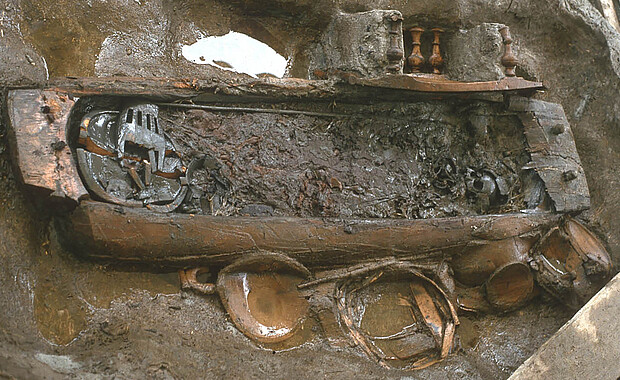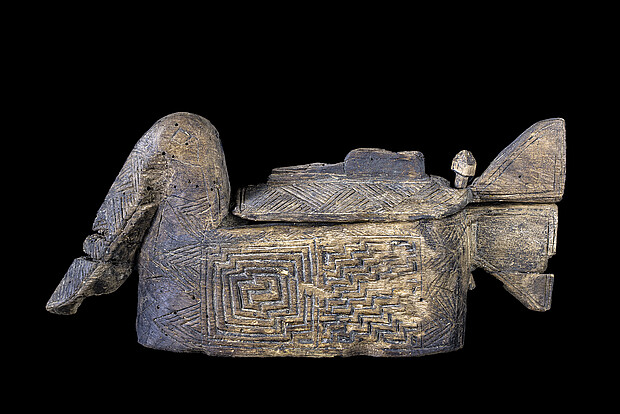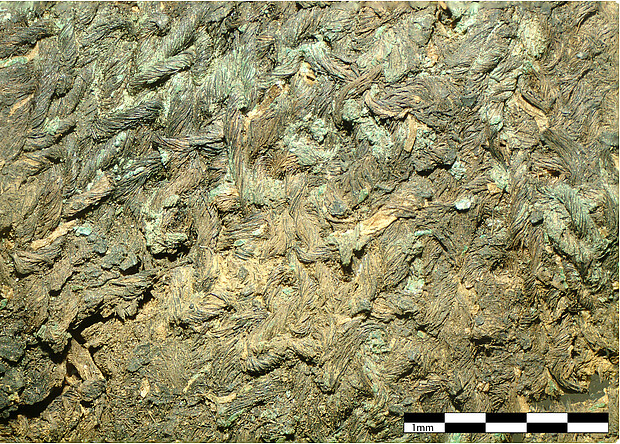The burial customs of the late RKZ and VWZ in northwestern Germany as reflected in grave equipment and items made from organic materials
The Department for Archaeological Heritage Management of the district of Cuxhaven excavated in the 1990s approximately 200 cremation and around 60 inhumation graves north of the Terp Fallward near Wremen (district of Cuxhaven). These features formed part of a cemetery dating to the period between beginning of the 4th and the second half of the 5th century AD. Some of the inhumation graves had been dug down deeply in the water saturated clay layers of the outer Weser riverine levee. This sediment ensured excellent conservation conditions for organic material.
In addition to the skeletons and wooden grave constructions, these burials also contain complete inventories of items from a wide variety of organic and inorganic materials. Part of the grave goods was also a block chair, which is unique in Europe and decorated with notch-cutting technology - which has become known internationally as the “throne from the march”.
The excellent state of preservation of the graves offers the unique opportunity to study and reconstruct the burial customs and traditions of a late Antique settlement area located in the Barbaricum, but that had close contacts to the late Roman Empire as well as to Scandinavia and the British Isles.
In a three-year research project funded by the German Research Foundation (DFG), six well-preserved graves will be investigated thoroughly, applying a bundle of scientific methods, particularly from textile archeology (Christina Peek), dendrochronology (Aoife Daly), anthropology (Silke Grefen-Peters), palaeogenetics (Ben Krause-Kyora) und palaeobotany (Steffen Wolters). The investigations will be conducted in close cooperation with the excavator Matthias D. Schön and the district of Cuxhaven (district administration, Museum Burg Bederkesa).
The aim of the project is not only to investigate the individual grave findings, i.e. the entire equipment, but also to reconstruct the exact sequence of the funeral rituals or ceremonies as accurate as possible in order to gain reliable insights into the social organization of the funeral practice.
During the project the finds from a selection of graves were comprehensively photographed for the first time. Rolf Kiepe succeeded in taking spectacular photographs, that enable a completely new, namely aesthetic approach to the extraordinary artefacts made of organic materials. In addition, numerous details that have hardly been noticed until now can be seen, which provide far-reaching information about everyday life in the area of the connected proto-historic settlement site. These unique photographs have been brought together in a book with contributions by Christina Peek, Andreas Hüser and Uta Maria Meier on the latest results of current research, making them accessible to a wide audience. The volume was published by VML Verlag Marie Leidorf in June 2022 and is available there.
The illustrated book with a summary of the research results to date is available from Marie Leidorf or in the Museum Burg Bederkesa
References
C. Peek, A. Rast – Eicher, I. Vanden Berge, Neu Untersuchungen an kaiserzeitlichen und frühmittelalterlichen Textilien aus Fundplätzen des südlichen Nordseeküstengebietes. Siedlungs- und Küstenforschung im südlichen Nordseegebiet 40, 2017, 97-131.
M.D. Schön, Germanische Holzmöbel von der Fallward in Niedersachsen. In: L. Wamser (Hrsg.), Die Römer zwischen Alpen und Nordmeer: zivilisatorisches Erbe einer europäischen Militärmacht. Schriftenreihe der Archäologischen Staatsammlung 1 (München 2000) 231.236.
M.D. Schön, Gräber des 4. und 5. Jahrhunderts in der Marsch der Unterweser an der Fallward bei Wremen, Ldkr. Cushaven. In: M. Fansa/ F. Both/ H. Haßmann (Hrsg.), Archäologie – Land – Niedersachsen. 400 000 Jahre Geschichte. Archäologische Mitteilungen aus Nordwestdeutschland, Beiheft 42 (Stuttgart 2004) 526-534.
M.D. Schön, Gräber eines „Herrenhofes“ an der Fallward bei Wremen, Landkreis Cuxhaven. Siedlungs- und Küstenforschung im südlichen Nordseegebiet 33, 2010, 77-85.



